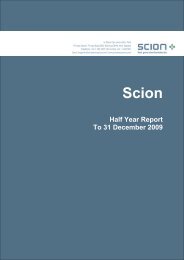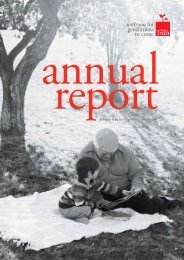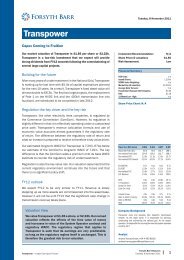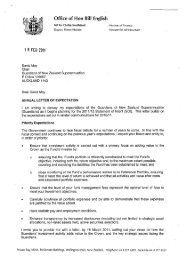apr-11.pdf (2.07 MB) - Crown Ownership Monitoring Unit
apr-11.pdf (2.07 MB) - Crown Ownership Monitoring Unit
apr-11.pdf (2.07 MB) - Crown Ownership Monitoring Unit
You also want an ePaper? Increase the reach of your titles
YUMPU automatically turns print PDFs into web optimized ePapers that Google loves.
Special Topic: Commercial PriorityPortfolio Economic Profit AnalysisErnst & Young (EY) was commissioned by COMU to undertake ananalysis of the economic profits of commercial priority portfoliostate enterprises (all operational SOEs plus Air NZ, Public Trust andTVNZ) 10 over a 10-year period.This special topic summarises the results of the analysis, which concluded that theportfolio generated returns in excess of its cost of capital over the period. The full reportis available on COMU’s website.What is economic profit?Economic profit (EP) is a measure of profit that takes into account the opportunitycost of capital tied up in a business. In an environment where <strong>Crown</strong> capital is scarceand subject to competing demands, state enterprises must not only break even on anaccounting basis, but also have sufficient earnings to cover the cost of the capital usedin financing their operations.There is no “standard” methodology for EP. EP is generally calculated by subtractingCapital Charge from Net Operating Profit after Tax (NOPAT), where Capital Chargeequals Invested Capital multiplied by Weighted Average Cost of Capital (WACC).Another important measure of an EP analysis is Return on Invested Capital (ROIC).ROIC is important in that when ROIC exceeds WACC, a company generates an EP.Each methodology variation has its own terminology and assumptions around each ofthe variables. A widely used form of EP is Economic Value Added (EVA), a proprietaryproduct from Stern Stewart & Co.EP is a useful indicator of performance. However, as with any metric, it does notprovide a complete performance assessment and is dependent upon assumptionsused and accounting policies adopted by each company 11 . As such, care needs to betaken in interpreting outputs; trends in EP can provide as much information as absolutevalues. For this reason, a 10-year analysis of EPs has been undertaken.The Ernst& Youngeconomicprofit analysisconcludedthat theportfoliogeneratedreturns inexcess of itscost of capitalover theperiodEY’s analysis shows positive EPs for the commercial priority portfolio(excluding KiwiRail) in eight of the last 10 yearsFigure 13 summarises, at a portfolio level, the outputs of EY’s analysis. Adistinguishing feature of the EY methodology (summarised at the end of this section)is the inclusion of asset revaluations in assessing NOPAT. This is on the basis thatrevaluation gains or losses reflect changes in economic income. To the extentthere are differences between revaluations and true market values of the assets, themeasurement will not accurately reflect economic income.10 <strong>Crown</strong> Fibre Holdings is excluded given its recent incorporation.11 In particular, the choice of WACC to establish the benchmark for measuring EP is not straightforwardand often controversial. WACC cannot generally be observed. Rather it is a theoretical estimate. Thereare a number of methodologies for estimating WACC. The estimate of WACC each method producesdepends crucially on the input assumptions. The EY approach, for example, uses a one-year risk-free rate.Companies’ own estimates of WACC often use a longer-term rate to reflect more accurately the longer-termnature of their actual financing arrangements.page | 31
















